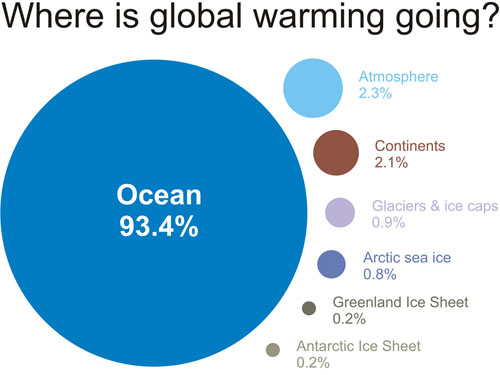In the past week, two key examples have emerged illustrating how the two sides of the climate science debate react to mistakes. In both cases, the scientists made the same basic errors, but drew opposite conclusions (both wrong) about the near-term warming of the planet. The media responses to these miscalculations by each side show a sharp contrast.
An Argentinian environmental group called Universal Ecological Fund (FEU) released a report which incorrectly stated that the planet will warm approximately 1.5°C between now and 2020. In a contrasting article, Dr. Richard Lindzen (a prominent climate scientist who is skeptical that the consequences of global warming will be dangerous), argued that we are already over 80% of the way to the greenhouse gas levels that the intergovernmental Panel on Climate Change (IPCC) claims will cause a 2-4.5°C increase in global temperatures. But global temperatures have only risen by less than 1°C, so, Lindzen argues, The IPCC predictions are wrong and we have nothing to worry about.
Both Dr. Lindzen and the FEU rely upon the IPCC's estimated range of values for the climate sensitivity, which is the factor that tells us how much the planet will warm in response to a doubling of atmospheric carbon dioxide. What both parties stumbled over is the fact that this factor tells us how much the planet must warm to reach an equilibrium in radiated power. When the greenhouse effect is increased, the Earth's heat radiation is impeded - global warming is the planet's way of restoring its full ability to get rid of heat. However, this warming doesn't happen instantly. The Earth is covered in oceans, and as anyone who has tried to make a hot beverage will tell you, water is slow to heat up.
The illustration below shows that over 90% of the heating goes into warming the oceans. That means that even when we stop increasing the greenhouse effect, there will be a considerable delay while the oceans, lands, etc. warm to their respective equilibrium temperatures

The mistake made by the FEU was to assume that the full impact of the added CO2 would be reached within a decade: that was wrong, the lag is far greater. The mistake made by Dr. Lindzen was to assume that the full impact of the CO2 added to date was already being felt: that was wrong, for exactly the same reason. In fact, the planet has warmed approximately 0.8°C over the past century, and the IPCC estimates that if we were to freeze atmospheric greenhouse gases at today's levels, the planet would continue to warm another 0.6°C before reaching equilibrium.
Both the FEU and Dr. Lindzen calculated the amount of global warming we expect from all man-made greenhouse gases (carbon dioxide, methane, etc.). However, neither accounted for man-made emissions of aerosols (small particles from fossil fuel combustion which block sunlight and cool the Earth's surface), or other cooling effects.
By accounting for all human-caused warming effects but neglecting our cooling effects, Dr. Lindzen and the FEU both over-estimated how much warming we expect to see in the short-term. However, the two drew dramatically different conclusions from this mistake. The FEU, thinking that we should expect to see the full equilibrium temperature for our level of CO2 almost immediately, concluded that we should expect to see exceptionally rapid global warming over the next decade; whereas Dr. Lindzen, thinking that we are already experiencing the full equilibrium temperature for our level of CO2 now, concluded that continued global warming will be nothing much to worry about.
The response to the FEU errors has been straighforward and comprehensive. Several journalists, climate bloggers, and climate scientists informed the FEU of their mistakes prior to the report's release. Unfortunately, for various reasons, the report was released anyway.
In a strong showing of scientific and journalistic integrity, a number of media sources have devoted articles to noting and correcting the errors in the FEU report, including The Guardian, RealClimate, The Huffington Post, and many others. Rather than deny, ignore, or propagate the errors, scientists and the media immediately acknowledged and corrected them.
By contrast, former TV weatherman Anthony Watts' popular global warming skeptic blog, WattsUpWithThat, soon ran Lindzen's article with no commentary or analysis. As a result, Lindzen's errors and incorrect conclusions were propagated to a much larger audience, which, based on the blog comments, was very receptive to the article. The article was soon re-published by The National Review and numerous other blogs and media sources, with a distinct lack of analysis or commentary. Lindzen's errors continue to spread, unacknowledged and uncorrected.
Ironically, Watts' blog also ran a story which was highly critical of Scientific American for initially publishing an article containing the FEU errors. However, just a few hours later, Scientific American ran a new story correcting the FEU errors. One wonders when Watts will correct his own blog's propagation of Lindzen's errors.
The examples above are fairly representative of the behavior of scientists, bloggers, and global warming "skeptics." Self-proclaimed "skeptics" will pounce upon any mistake made by climate scientists with the zeal of sharks smelling blood in the water. Yet mistakes by a fellow skeptic like Dr. Lindzen are passed over in silence, and his erroneous conclusions are promoted and propagated.
Skepticism, in its true sense, means examining all evidence with an equally critical eye. A true skeptic should also look for mistakes made by those on his side; and if he encounters them, he should acknowledge and correct them. In this case study, the true skeptics were the climate scientists and journalists. Those who wish to be considered honest skeptics should take note of their commendable behavior.

